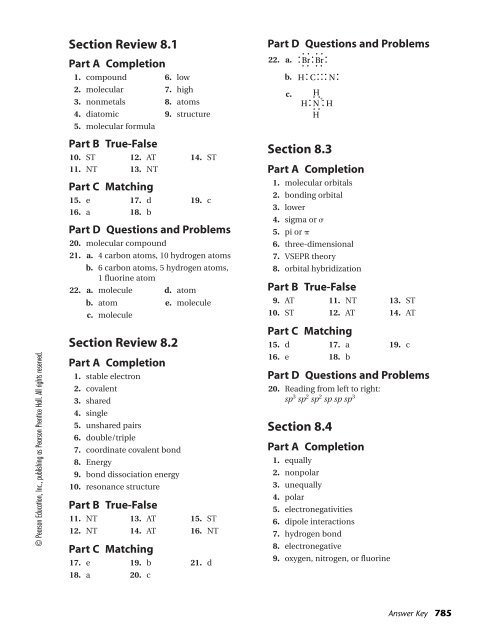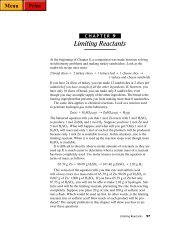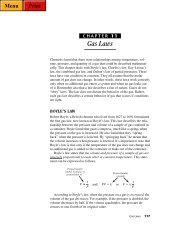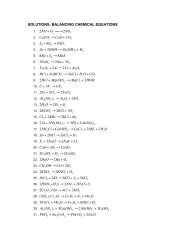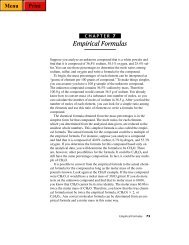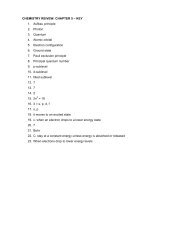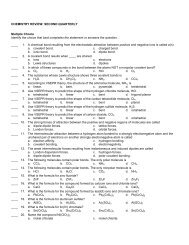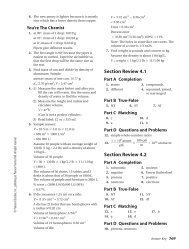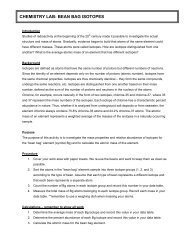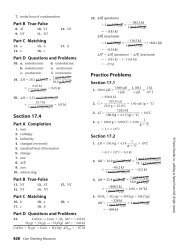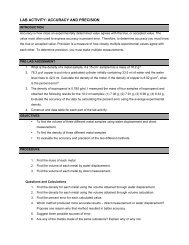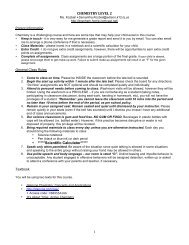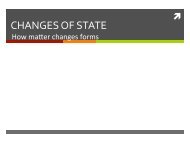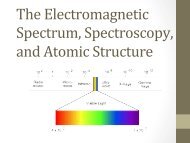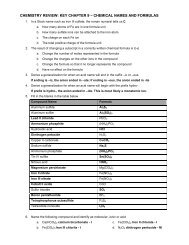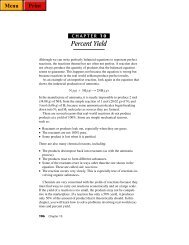You also want an ePaper? Increase the reach of your titles
YUMPU automatically turns print PDFs into web optimized ePapers that Google loves.
© Pearson Education, Inc., publishing as Pearson Prentice Hall. All rights reserved.<br />
Section Review 8.1<br />
Part A Completion<br />
1. compound 6. low<br />
2. molecular 7. high<br />
3. nonmetals 8. atoms<br />
4. diatomic<br />
5. molecular formula<br />
9. structure<br />
Part B True-False<br />
10. ST 12. AT 14. ST<br />
11. NT 13. NT<br />
Part C Matching<br />
15. e 17. d 19. c<br />
16. a 18. b<br />
Part D Questions and Problems<br />
20. molecular compound<br />
21. a. 4 carbon atoms, 10 hydrogen atoms<br />
b. 6 carbon atoms, 5 hydrogen atoms,<br />
1 fluorine atom<br />
22. a. molecule d. atom<br />
b. atom<br />
c. molecule<br />
e. molecule<br />
Section Review 8.2<br />
Part A Completion<br />
1. stable electron<br />
2. covalent<br />
3. shared<br />
4. single<br />
5. unshared pairs<br />
6. double/triple<br />
7. coordinate covalent bond<br />
8. Energy<br />
9. bond dissociation energy<br />
10. resonance structure<br />
Part B True-False<br />
11. NT 13. AT 15. ST<br />
12. NT 14. AT 16. NT<br />
Part C Matching<br />
17. e 19. b 21. d<br />
18. a 20. c<br />
Part D Questions and Problems<br />
22. a.<br />
b.<br />
c.<br />
6-9Br 6-9Br 6<br />
H 6 C 6 6 6 N 6<br />
H<br />
H 6-9N <br />
6 H<br />
H<br />
Section 8.3<br />
Part A Completion<br />
1. molecular orbitals<br />
2. bonding orbital<br />
3. lower<br />
4. sigma or <br />
5. pi or <br />
6. three-dimensional<br />
7. VSEPR theory<br />
8. orbital hybridization<br />
Part B True-False<br />
9. AT 11. NT 13. ST<br />
10. ST 12. AT 14. AT<br />
Part C Matching<br />
15. d 17. a 19. c<br />
16. e 18. b<br />
Part D Questions and Problems<br />
20. Reading from left to right:<br />
sp 3 sp 2 sp 2 sp sp sp 3<br />
Section 8.4<br />
Part A Completion<br />
1. equally<br />
2. nonpolar<br />
3. unequally<br />
4. polar<br />
5. electronegativities<br />
6. dipole interactions<br />
7. hydrogen bond<br />
8. electronegative<br />
9. oxygen, nitrogen, or fluorine<br />
Answer Key 785
Part B True-False<br />
10. NT 12. ST 14. AT<br />
11. AT 13. ST 15. AT<br />
Part C Matching<br />
16. b 18. e 20. a<br />
17. d 19. c<br />
Part D Questions and Problems<br />
21. dispersion forces, dipole interactions,<br />
hydrogen bonds<br />
22. a. ionic<br />
b. polar covalent bonds<br />
c. polar covalent bonds<br />
d. nonpolar covalent bonds<br />
Practice Problems 8<br />
Section 8.1<br />
1. a. atom d. molecule<br />
b. molecule e. atom<br />
c. molecule<br />
2. a. not diatomic<br />
b. diatomic<br />
c. diatomic<br />
d. not diatomic<br />
e. diatomic<br />
3. Molecular compounds are usually composed<br />
from two or more nonmetallic elements.<br />
4. A molecular structure gives information<br />
about the kinds and numbers of atoms<br />
present in a molecule.<br />
5. Molecular compounds tend to have lower<br />
melting and boiling points that that of ionic<br />
compounds<br />
Section 8.2<br />
1. The two atoms share a pair of electrons in<br />
order to form a single covalent bond.<br />
H F<br />
2. Phosphorous needs 3 more electrons to fill<br />
the 3p orbitals. Fluorine needs one more<br />
electron to fill its second energy level. Since<br />
each fluorine atom only needs one electron<br />
and phosphorus needs 3 electrons, three<br />
fluorine atoms are required to bond with<br />
phosphorus.<br />
F P<br />
F<br />
786 Core Teaching Resources<br />
F<br />
3. Nitrogen needs 3 more electrons to fill its<br />
second energy level. Chlorine needs one<br />
more electron to achieve a noble gas<br />
configuration. Because each chlorine atom<br />
needs only one electron and nitrogen needs 3<br />
electrons, three chlorine atoms are required<br />
to bond with nitrogen.<br />
4. Because carbon can form four single covalent<br />
bonds, there is an apparent shortage of atoms<br />
with which to bond. This is a clue that a<br />
carbon-carbon multiple bond exists in this<br />
compound. Each carbon atom shares one<br />
electron with one of the two hydrogen atoms.<br />
The remaining three electrons for each<br />
carbon atom form a triple covalent bond. The<br />
electron dot structure is:<br />
HCCH<br />
5. Carbon has 4 valence electrons and each of<br />
the oxygens has 6 valence electrons. Two<br />
additional electrons are added to account for<br />
the ion having a 2 charge. The carbon and<br />
oxygen can satisfy the octet rule by having the<br />
oxygens bonded to a central carbon. There is<br />
one double covalent bond between a carbon<br />
and oxygen, which can shift to any one of the<br />
carbon-oxygen bonds giving rise to three<br />
resonance structures.<br />
O<br />
C<br />
O O<br />
Section 8.3<br />
Cl N Cl<br />
Cl<br />
2 O<br />
C<br />
O O<br />
1. The four fluorine atoms are covalently<br />
bonded to the central carbon atom. The four<br />
shared pairs of electrons repel each other to<br />
the corners of a tetrahedron. All four bond<br />
angles are 109.5°.<br />
2. The four valence electron pairs repel each<br />
other, but the unshared pair is held closer to<br />
the phosphorus than the three bonding pairs.<br />
The unshared pair repels the shared pairs<br />
more strongly. Thus, the angle between<br />
bonds is expected to be slightly smaller than<br />
the tetrahedral bond angle of 109.5. The<br />
actual bond angle for NH3 , a similar<br />
molecule, is 107.<br />
3. Boron forms three sp2 orbitals by mixing one<br />
2s orbital and two 2p orbitals. The three sp2 orbitals lie in the same plane, 120 apart from<br />
one another. Each sp2 orbital overlaps with an<br />
2<br />
O<br />
C<br />
O O<br />
2<br />
© Pearson Education, Inc., publishing as Pearson Prentice Hall. All rights reserved.
© Pearson Education, Inc., publishing as Pearson Prentice Hall. All rights reserved.<br />
atomic orbital of chlorine to form three<br />
equivalent sigma bonds.<br />
4. To form four equivalent bonds, silicon mixes<br />
one s orbital and all three of the p orbitals.<br />
The hybridization in SiF4 is sp3 .<br />
5. Oxygen is the central atom in this molecule. It<br />
has 6 valence electrons, two of which are<br />
bonding electrons. The other 4 electrons are<br />
unshared pairs. These 2 unshared pairs repel<br />
the two bonding pairs and prevent F2O from<br />
being linear. The molecule is a bent triatomic<br />
molecule, with a bond angle of approximately<br />
104.5°. This angle is slightly smaller than the<br />
tetrahedral bond angle because the two<br />
unshared pairs repel each other more<br />
strongly than the two shared pairs.<br />
6. Because each carbon can form single<br />
covalent bonds with four other atoms, there<br />
exists in this compound an apparent<br />
shortage of atoms with which to bond. This is<br />
a clue that CH2CF2 contains a carbon-carbon<br />
multiple bond. The two hydrogen atoms<br />
bond with one carbon atom while the two<br />
fluorine atoms bond with the other carbon.<br />
Each carbon atom has two electrons left over.<br />
These electrons form a carbon-carbon<br />
double covalent bond. The molecule looks<br />
very much like the ethene molecule (C2H4 ).<br />
H2C2H and F2C2F bond angles of 120°, the<br />
hybridization involved in the carbon-carbon<br />
bond is sp2 .<br />
H F<br />
C C<br />
H F<br />
7. Carbon 1 mixes one s orbital and three p<br />
orbitals to form four sp 3 hybrid orbitals,<br />
which form 4 sigma bonds. Carbon 2 mixes<br />
one s and two p orbitals to form three sp 2<br />
hybrid orbitals, which overlap with the<br />
hybrid orbitals of the carbon and oxygen<br />
atoms to form three equivalent sigma bonds.<br />
The non-hybridized p carbon orbital overlaps<br />
with an oxygen p orbital to form one pi<br />
bonding orbital.<br />
Section 8.4<br />
1. a. The difference in electronegativity<br />
between Na and O is about 2.4 and the<br />
bond is ionic.<br />
b. With like atoms, the difference is zero and<br />
the bond is nonpolar covalent.<br />
c. The electronegativity difference between<br />
P and O is about 1.4 and the bond is polar<br />
covalent.<br />
2. For a bond to be classified as nonpolar<br />
covalent, like atoms must bond, as in<br />
diatomic molecules. Most bonds are between<br />
unlike atoms; therefore, they must be ionic or<br />
polar covalent.<br />
3. Both carbon dioxide and carbon monoxide<br />
contain polar bonds. However, the effect of<br />
the polar bond on the polarity of the entire<br />
molecule depends on the shape of the<br />
molecule. In carbon monoxide, there is a<br />
partial positive pole and a partial negative<br />
pole. Therefore, the molecule is a dipole. In<br />
carbon dioxide, the carbon and oxygens lie<br />
along the same axis. The bond polarities<br />
cancel, producing a nonpolar molecule.<br />
4. The more electronegative atom in a covalent<br />
bond will have the symbol and the less<br />
electronegative atom the symbol.<br />
a.<br />
H<br />
H N H δ+<br />
δ+<br />
δ+ δ–<br />
b.<br />
δ–<br />
F<br />
Fδ–<br />
δ+<br />
C<br />
δ–<br />
F<br />
Fδ–<br />
5. CaO is an ionic compound and CS2 is a polar<br />
covalent compound. Generally, ionic<br />
compounds have much higher melting<br />
points than molecular compounds.<br />
Interpreting Graphics 8<br />
1. O 3 C 3 O ; linear; 180°; none<br />
2.<br />
H H<br />
; tetrahedral; 109.5°; none<br />
C<br />
H H<br />
3. O O ; trigonal planar; 120°;<br />
S<br />
O<br />
O<br />
S<br />
O O<br />
4. F Be F ; linear; 180°; none<br />
O<br />
S<br />
O O<br />
O<br />
S<br />
O O<br />
Answer Key 787


